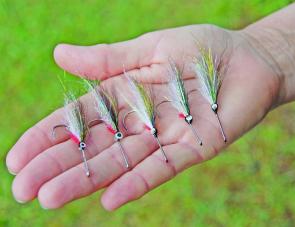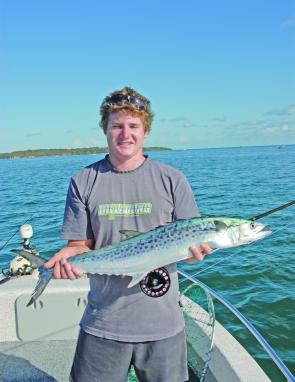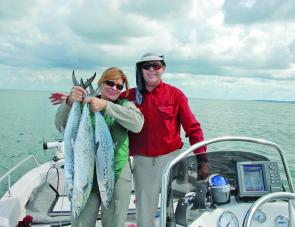On-the-boil about sums up the action happening just after first light in Moreton Bay this month. On the right day, with the early morning breeze barely rippling the Bay's surface, there will be flocks of birds diving onto the action as schools of mackerel and perhaps northern blue fin tuna (although it is a little early for these fellows) get stuck into hapless bait fish.
A morning with a fair amount of tide run is arguably best, especially if a flood tide has commenced around four o'clock. As soon as the water starts to move to the south the big fellows will be working the edges of banks such as the Moreton, Chain or Maroom Banks on the eastern side of the Bay, or perhaps further over against the Amity Banks adjoining the Rainbow Channel. The odd splash, perhaps a suddenly diving bird; all are indicators of fish in the vicinity.
Find the birds and the fish will be below. Even if the birds are spiralling upwards in the one area or just moving slowly around, looking down, patrolling the edge of a bank in anticipation. As the day becomes much brighter we can find our target fish in the more open areas, perhaps between Moreton Island and Mud Islands, or between the Harry Atkinson artificial reef and Green Island. Other times a careful run up the Rous Channel is well worth the effort.
With feeding fish in sight and the heart starting to pump it's a matter of good tactics to secure the hook up. Mackerel, in particular, are not nearly as wary of boats as the bay's tuna species and can usually be approached to within casting range so long as one does not roar in on full plane as some folk like to do. Slow and steady is the way to go and if the fish do appear on the sounder but have not been spooked by the boat they won't take long to give the angler another chance.
One thing about mackerel is their feed and travel routine can usually be worked out fairly easily and one can position the boat within easy casting range in anticipation of the next work up.
How do we ascertain what species is on the job? Perhaps the surest indication of what is in store is the tuna usually show the tail or back as they grab a mouthful, whereas mackerel tend to slash the surface in a showier feeding manner. Yet mackerel can also sometimes be far more discreet than tuna, in that they might only show the tip of the mouth as they snip at the bait. It depends on how excited the fish are at the time, I guess, the latter tactics usually being seen later in the day when the fish are nearly finished the early morning session.
With fish in sight it's time to get some fly line in the air and start a bit of false casting to gain distance. Neither macs nor tuna appreciate a boat too close so a long cast is the one most likely to succeed. Ten weight tackle is around right for these blokes: last year in the Rainbow Channel there were some really big fish among the run of spotties and they had bars on their sides. Spanish? You bet. One would have to be keen to use an eight weight outfit on fish of this class.
Along with a ten weight fly rod the chosen reel should have at least 150m of backing (My Snowbee XS large Arbor 910 is set up with 300m of 5lb Bionic Braid) behind the fly line and be equipped with a drag that can be relied upon without hesitation.
Most anglers rely on an intermediate fly line for this work, and clear is the clue. Mackerel and tuna will both spook if a fancy coloured fly line throws a shadow on them as they feed so the clear line takes care of that problem. A leader of around a rod's length is about right with quality fluorocarbon, about 10kg breaking strain, as a tippet to connect the fly. Wire is a last resort, as the mackerel won't take the fly as readily. If bite offs are happening consistently due to the fish being voracious one can upgrade the fluoro to 20kg b/s to stay connected. I use FC100 for my serious saltwater work and have found the stuff is easily knotted, isn't overly stiff, and comes in handy 100m spools. And it is hard to bite off.
Another way to get around the bite off issue is to tie the fly on a long shank 3/0 hook. Start the tying around half way up the shank, this leaves a decent amount of metal forward of the fly's head and the fish can bite on this all day without cutting off. This technique does not put off tuna, I even scored several nice fat long tails last year with these dedicated mackerel flies.
Surf candies, small deceivers, silvery clousers, glass minnows, and other small skinny flashy flies will work well on Moreton Bay's pelagics. Although I make the special mac flies on the larger long shank hooks a standard 2/0 is usually about right sized given the small bait fish abound in our waters. Gar and hardyheads are not usual food items but a couple of larger flies are always worth carrying as the odd cobia will hang about with the surface feeding schools and these bruisers will definitely take a larger fly in preference to a smaller one.
Whatever fly is chosen it must be worked back as fast as possible or the fish will only look, not take.
| There's not much choice really; either the fish is permitted to run off or something between fish and angler is quickly | going to pop. At this point tackle handling is a necessary skill. Cocking the wrist to one side will allow the fly line to run without catching on shirt sleeves and it pays to remember that loose turns of fly line are likely to catch on buttons, fingers or rod runners so keeping control of the fly line as it whips out is essential. Once backing is out of the rod tip the fish should not take long to tire from towing the fly line around the place and some pump and wind as opportunity presents should see him at the boat before too long. It's the angler's choice then, as to whether the fish is kept or released. |
|---|

Tuna will also take these smart little mackerel flies.

Scott Kampe with a nice mac taken from the eastern side of Peel Island.

The author and wife, Denise, with a feed of mackerel taken in the Rainbow Channel last November.




